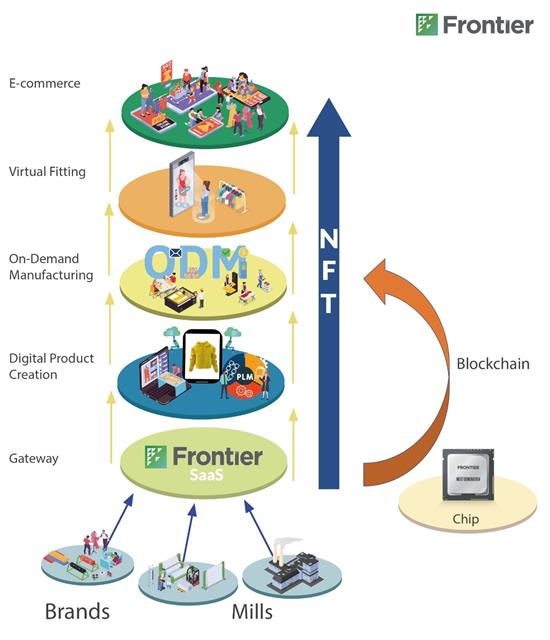Digital transformation has touched every industry around the world. However, because the textile industry chain is extremely long and complicated, the process of digitalization has become equally complicated.
Digital design has grown in popularity over the last few years, especially 3D digital design. As a result, many major brand manufacturers such as Nike, Adidas and New Balance are now requiring that textile supply chains have digital work process capabilities. Additionally, due to online clothing sales increasing annually and fast fashion shortening product lifecycles, the digital textile trend in the traditional textile industry has been further accelerated.
The market outlook for the growth of the digital textile industry is optimistic, which is being accelerated by relevant funding. Taiwan-based startup company Frontier is focused on the digitalization of textile industry processes. Frontier uses artificial intelligence (AI) recognition technology to help introduce textile supply chains to the new digital textile world.
Digitalization soars alongside online sales figures
Frontier CEO Victor Chao observed that increasing online clothing sales is a major driver of digitization in the textile industry. For example, in the US market, online clothing sales reached US$110.6 billion in 2020, accounting for 46% of all sales. Online clothing sales in the UK, Italy and France were not far behind.

Frontier CEO Victor Chao
Pholto: Company
However, the biggest pain point for online sales is the return rate. According to a survey, the return rate for online sales in the US was 21%, which amounts to over US$20 billion. To reduce the return rate, the virtual fittings concept was developed. As a result, all clothing must be digitalized. Consumers can also create a digital avatar to help them select clothing best suited to their body type.
In the future, the same clothing styles will have more size options, including custom sizes. Providing customers with a customized shopping experience that allows them to provide their measurements and find the best fit for their body type will become even more important. To meet the demands of limited quantity, more choices and high customization, the textile industry must accelerate the digitalization of its work processes. From the textile supply chain to brand designers, every link in the chain must digitalize.
Chao said that Frontier wants to bring the global textile industry into the digital world, and create digital assets that will increase the value of digital processes. However, digitalizing fabric is difficult. The current method is to purchase millions of lightboxes or send them to a lab for scanning, which limits the digitalization opportunity for the majority of the textile industry.
Seeing that digital materials are the key to entering the digital textile industry, Frontier proposed a solution that allows companies to directly upload digital assets using their existing printers. The fabric's details are then restored via cloud AI. The solution enables companies to form the biggest economies of scale.

Many fashion brands have not been able to mass produce virtual clothing. Frontier.cool and E-Elements Technology have teamed up to use a system on a chip that combines Arm-based processors and FPGA to develop the Fabric Meta solution.
Photo: Company
As a result, the Software as a Service (SaaS) cloud platform service provided by Frontier allows fabric factories to use printers to directly scan and upload fabrics. Through AI technology, Frontier can turn 2D layers into 3D layers and calculate the physical data into 4D ready material. Not only can it be used directly on 3D models, but it can also simulate the movement and stretch of the fabric when walking.
In the past, manufacturing a single item of clothing would take 3-6 months from design to customer. Now, with digital fabrics, it only takes one week from online design to complete the entire work process.
Improving edge computing capabilities with Arm partnership
Chao said uploading large amounts of fabric is a burden on cloud computing resources. If it can be processed first on the edge, the burden on cloud demand can be reduced and work can be accelerated.
It only takes 30 seconds to scan a piece of fabric and create a digital fabric file using Frontier's system, which is vastly more efficient compared to the 30-60 minutes it takes using a lightbox. However, to meet future requirements for more fabrics, faster and higher resolution uploads, Frontier has partnered with Arm to develop the world's first textile chip.
Through this partnership, Arm's main customer Xilinx provides an FPGA chip equipped with Arm's CPU. Solutions provider E-Elements Technology then helps transplant Frontier's AI processing engine and algorithms onto the FPGA chip and further integrates it into a system module.

Arm's main customer Xilinx is providing an FPGA chip equipped with Arm's CPU. With E-Elements Technology's help, Frontier is developing the world's first textile chip.
Photo: Company
Helping reduce costs and carbon emissions
Once fabric data from all over the world is uploaded, the needs of both the supply and demand ends can be met on Frontier's platform. Through the platform, companies can obtain information about the fabric supplier and country of origin, as well as calculate customs duties and transportation costs. In the future, the platform will be able to provide more information and services, including reducing overall costs and assisting companies with carbon emissions management.
Frontier is also working with the largest fabric certification company in Europe. Once a fabric has been certified, the certification information will appear on the platform for brand owners to reference. In other words, customers do not need to build their own complex databases and can eliminate hardware equipment. Using Frontier's digital tools is not only convenient but also makes it even easier for users to utilize digital fabrics.
In terms of reducing carbon emissions, Frontier is working with a UK-based environmental consultant to calculate the carbon emissions of different fabrics based on the yarn used, the quantity used and the color. Now, the carbon footprint of every piece of clothing can be calculated, which will further help textile companies wanting to strengthen their commitment to reducing carbon emissions and environmental protection issues. This concept will be shared at CES 2022.

The Frontier team
Photo: Company




